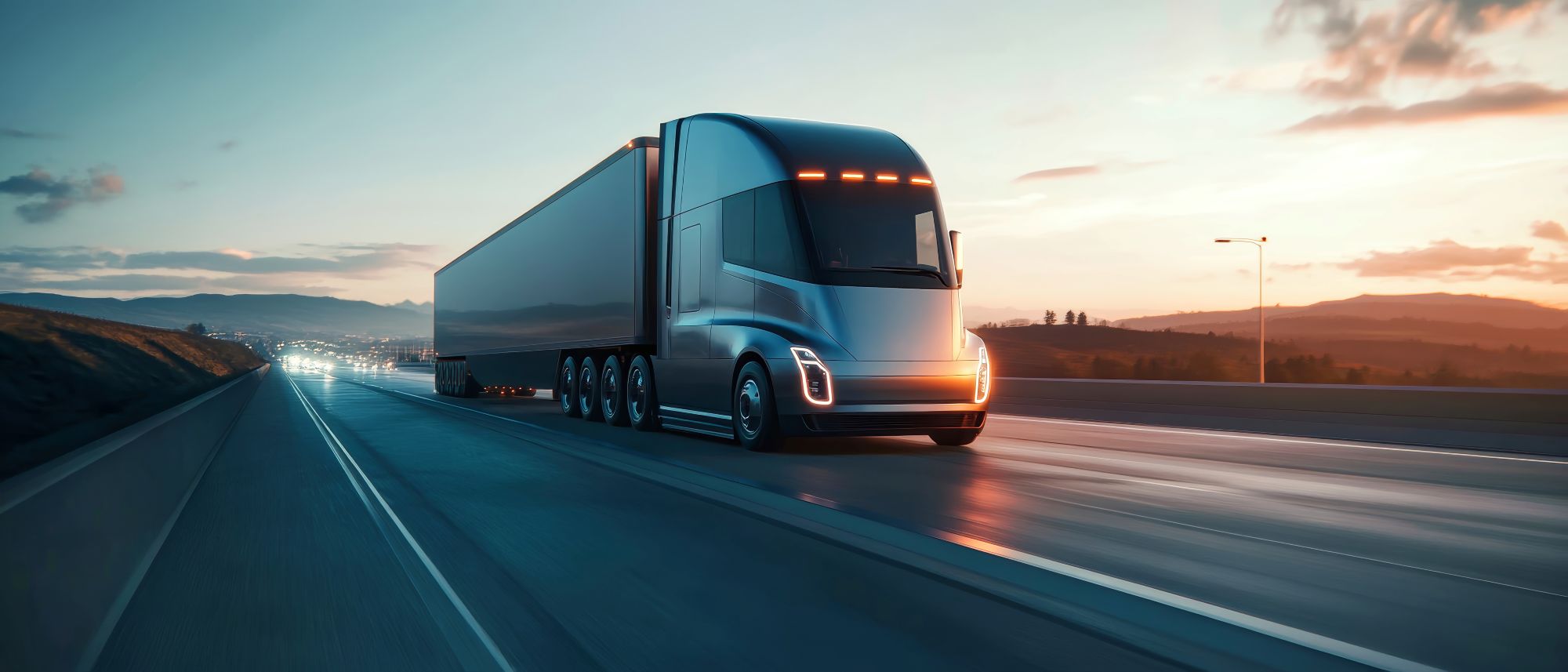
Miranda Blake
2025 m. sunkiasvorių sunkvežimių vairuotojų diena: Sunkvežimių vairuotojams suteikiamas balsas
Sukurta: 22-01-2025
•
Atnaujinta: 22-01-2025
2025 m. sausio 22 d. - sunkiasvorių sunkvežimių vairuotojų diena. Šią dieną įsteigė "NN1 Personnel" (sunkvežimių vairuotojų įdarbintojai ir tiekėjai logistikos pramonėje), o jos tikslas - pagerbti vairuotojus ir visa tai, ką jie daro ekonomikai ir visuomenei.
Be sunkvežimių vairuotojų, kurie dažnai susiduria su įvairiais sunkumais (be kita ko, būna toli nuo savo šeimų ir namų, ilgai dirba ir keliauja ekstremaliomis oro sąlygomis), neturėtume reikalingų produktų ir patogumų. Per pastaruosius kelerius metus ir anksčiau jie iš tiesų buvo didvyriai - pandemija buvo tik vienas to pavyzdys.
Kaip pažymėsite šią dieną, priklauso nuo jūsų. [NN1 Personalas rekomenduoja parodyti gerumą] (https://nn1personnel.co.uk/celebrating-hgv-drivers-day-2/#:~:text=Why%20have%20we%20created%2022nd,the%20applause%20they%20truly%20deserve.), pavyzdžiui, pavaišinti vairuotojus karštu gėrimu arba su jais pabendrauti.
Čia, SNAP, visada siekiame, kad sunkvežimių vairuotojai išreikštų savo nuomonę. Todėl šią sunkvežimių vairuotojų dieną būtent tai ir darome. Po neseniai mūsų Facebook puslapyje paskelbto įrašo, kuriame buvo klausiama apie vairuotojų trūkumą ir apie tai, kaip užtikrinti, kad jaunimas su entuziazmu įsitrauktų į šią pramonės šaką, pateikiame keletą sunkvežimių vairuotojų komentarų, kuriuose atsispindi jų reali patirtis - nuo iššūkių, su kuriais jie susiduria, iki to, kas jiems patinka jų darbe.
Darbo ir asmeninio gyvenimo pusiausvyra
Vairuotojai dažniausiai kalba apie tai, kokią įtaką jų asmeniniam gyvenimui daro darbas, pavyzdžiui, kad jie negali būti šalia svarbiais gyvenimo momentais, kad jiems tenka miegoti kabinoje ir kad pinigai nėra verti jų aukų.
"Vairuojant sunkvežimį visada buvo blogai mokamas atlyginimas, ilgos darbo valandos ir beveik jokio socialinio gyvenimo. Dabartinis jaunimas nesitaikstys su kvailomis darbo valandomis, nes dauguma jų turi gyvenimą už darbo ribų. ".
"Nerekomenduočiau, nebent tai yra jūsų kraujyje. Tai nėra įprastas darbas, tai gyvenimo būdas. Turite suprasti, į ką įsitraukiate. Jūs negaunate reguliaraus darbo pradžios ir pabaigos laiko kaip gamykloje. Viskas priklauso nuo darbo pobūdžio. Tikimasi, kad dirbsite 15 valandų pamainomis ir naktimis kabinoje, nes to reikalauja darbas - ir nusispjausite į savo namų gyvenimą. ".
"Vidutiniškai 70 valandų per savaitę už 50 tūkst. svarų sterlingų per metus tiesiog nebėra verta. Minimalus atlyginimas sparčiai artėja prie vidutinio sunkvežimio vairuotojo atlyginimo, todėl tiesiog dirbsiu viršvalandžius gamykloje už panašius pinigus ir kiekvieną vakarą matysiu žmoną. ".
"60/65 valandų per savaitę, 3/4 vakarų, jokio socialinio gyvenimo - už uždirbtus pinigus galėtum lygiai taip pat krauti lentynas "Aldi" ir gyventi. Nauji vairuotojai, pradedantys dirbti, nenori dirbti tiek valandų ar praleisti tiek naktų už tuos pinigus, kuriuos uždirbate, faktas. Taigi, kai įmonės pradės mokėti vairuotojams daugiau, jos pradės pritraukti vairuotojų. ".
"Kiek tų, kurie pradėjo dirbti tuo pačiu metu kaip ir aš, tęsė darbą šioje srityje? Kiek žmonų pavargo nematyti savo vyrų? Kiek vairuotojų pavargo nematyti savo žmonų ir vaikų? "
"Kodėl jauni vairuotojai turėtų pradėti dirbti šioje srityje? Ilgos darbo valandos, menkas atlyginimas - jie gali uždirbti geriau ir gyventi labiau visuomenišką gyvenimą, jei mokysis ko nors kito. Deja, man jau per vėlu. ".
Statistiniai duomenys patvirtina atsiliepimus. Pavyzdžiui, nustatyta, kad [sunkvežimių vairuotojai kiekvieną savaitę dirba vidutiniškai 48 valandas] (https://www.gov.uk/government/statistics/road-freight-statistics-2023/overview-of-the-road-freight-sector-2023#:~:text=HGV%20drivers%20worked%20an%20average,(Šaltinis%3A%20Department%20for%20Transport)) - palyginti su 37,5 valandos visiems darbuotojams, tai yra gerokai 28 % daugiau. Ir todėl nenuostabu, kad tik trečdalis vairuotojų mano, kad jų darbdaviai palaiko profesinio ir asmeninio gyvenimo pusiausvyrą. Taip pat nešokiruoja, kad tokia didelė dalis vairuotojų paliko šį sektorių, įskaitant 67,21 % jaunesnių nei 30 metų vairuotojų, kurie per metus po pandemijos pakabino savo aukštus reikalavimus atitinkančius drabužius.
Gyvenimas po sunkvežimių
Kai kurie iš komentavusių darbuotojų perėjo iš šios pramonės šakos į kitas pareigas, kurios jiems teikia daugiau laimės.
"Gamykloje, kurioje apdirbamos detalės, man moka daugiau ir aš žinau, kada einu ir kada grįžtu namo, todėl man tai nė motais. "
"Mano vairuotojo pažymėjimas ir CPC tiesiog guli piniginėje. Dabar mokykite žmones vairuoti automobilius. "
"Nė trupučio to nepraleiskite. Licencija vis dar galioja. Tegul CPC eina. Užtenka. "
"Daugelį metų dirbau 1 klasėje ir negrįžčiau į ją, nes gamykloje galiu uždirbti tuos pačius pinigus ir gyventi šeimyninį gyvenimą. Tiesiog nebeverta!"
"Grįžau prie autobusų vairavimo, nes ten, kur gyvenu, už valandą mokama daugiau. 15 metų vairavęs sunkiasvorę krovininę transporto priemonę, aš labai mėgstu aštuonių valandų pamainas. Nesupranti, ką prarandi kokybiškai praleisdamas laisvą nuo darbo laiką, kol jo vėl nepatyrei. ".
Sekant šeimos pėdomis
Tačiau kiti prisiminė, kad vaikystėje su tėvais važinėjo sunkvežimiais, prisiminė, kad tai buvo vertinga ir kad ši patirtis paskatino juos pačius, baigus mokslus, pradėti dirbti šiame sektoriuje.
"Manau, kad pramonė labai negalvoja apie tai, kaip buvo auklėjami 21-erių metų jaunuoliai. Anksčiau jie važinėdavo su tėvais sunkvežimiais. Sunkvežimyje sėdintys vaikinai ugdė tiek pat smegenų įgūdžių, bet žiūrėjo į kelio numerius. "
"Kai vaikai nebegalėjo važiuoti su tėvais į vagoną per atostogas, jaunimas nustojo tuo domėtis. Pripažinkime: juk nėra jokios finansinės paskatos prisijungti, ar ne? "
"Nebuvo nė vienų mokyklinių atostogų, per kurias nebūčiau važiavęs su tėvu sunkvežimiu. "
"Prieš baigdami mokyklą jie puikiai išmanė šį darbą. "
"Buvo puiku vykti į Belgiją su tėčiu. "United Carriers" agentūrai "Protem Ltd" iš Kento. Paskui "Marley Extrusions". Tada ir dabar dirbu vairuotojo padėjėju, nes neturiu vairuotojo pažymėjimo - norėčiau jį turėti, bet mano regėjimas prastas, todėl dirbu vairuotojo padėjėju. Mėgstu būti savo sunkvežimiuose. "
Aistra darbui
Panašiai daugelis nesutiko, kad sunkvežimių vairavimas nėra idealus darbas, nesvarbu, ar dėl pinigų, ar dėl to, kad jiems patinka vairuoti sunkvežimį.
"Aš dirbu tris naktis per savaitę ir gaunu 45 tūkst. svarų sterlingų per metus. Parodykite man kitą darbą, kurį galėčiau gauti po dviejų savaičių mokymų ir už kurį mokėtų tiek!"
"Jau beveik 49 metus dirbu su autocisternomis, o sulaukęs 74 metų vis dar dirbu savaitgaliais ir vieną naktį per savaitę, ir galiu jus patikinti, kad gerų vyrų pramonėje trūksta. Daug gerų vyrų mirė anksčiau laiko. Jei galėčiau, tikrai viską pakartočiau dar kartą. ".
"Ši profesija arba patinka, arba ne. Man patiko tai daryti daugelį metų, o išvykdavau po 4-6 savaites. Daug kas gali priklausyti nuo to, į kokią įmonę įstojate. Aš savoje dirbau 32 metus. "
"Būdamas 19-os metų įgijau sunkiasvorio automobilio vairuotojo pažymėjimą. Jau beveik trejus metus važinėju keliais - labai patinka. "
"50 proc. vairuotojų nenorėjo išvykti, o savaitgaliais niekas nenorėjo išvykti. Maždaug visi man sakė: "Tu praleidai geriausius metus, sūnau, susirask kitą darbą". Tiesa buvo tokia, kad pinigai buvo neblogi, jei atidirbdavai valandas, o jei dirbdavai dėl pinigų, galėjai neblogai pragyventi. Jei norėjai lengvo gyvenimo geriausiuose sunkvežimiuose, daug poilsio ir kad tavimi rūpintųsi įmonė, buvai netinkamame darbe. "
"Visada dirbdavau daugiau nei 60 valandų per savaitę, turėjau gerą ir patogų gyvenimą, o svarbiausia - labai gerą, supratingą ir stiprią moterį šalia savęs. Ir taip, viską pakartočiau dar kartą. "
Sunkvežimių vairuotojų pripažinimas šią sunkvežimių vairuotojų dieną
Visi šie komentarai aiškiai rodo, kad nors sunkvežimių vairuotojai tikrai susiduria su iššūkiais, vis dar yra ką mylėti, o kai kuriems tai yra karjera, kurią jie mielai daro visą gyvenimą, todėl logiška, kad maždaug pusė vairuotojų jaučiasi patenkinti darbu.
Manome, kad labai svarbu, jog visi pripažintų viską, ką sunkvežimių vairuotojai daro dėl mūsų. Deja, kai kurie vairuotojai nurodė, kad jiems labai trūksta pagarbos. Taip neturėtų būti - jie turėtų būti pripažinti už tai, ką daro, kad suteiktų mums visas būtiniausias gyvenimo reikmes. Kaip sakė vienas sunkvežimio vairuotojas:
"Greitkeliai gali būti šalies venos, tačiau sunkvežimiai yra mūsų kraujas. Be jų neturėtume nei maisto produktų, nei prekių. "
Taigi, šią sunkvežimių vairuotojų dieną - ir iš tikrųjų kiekvieną kitą dieną - prašome visų atkreipti dėmesį į tuos, kurie dėl mūsų dirba kelyje. Sunkvežimių vairuotojai nusipelno pagyrimų, pagarbos ir daug daugiau.



